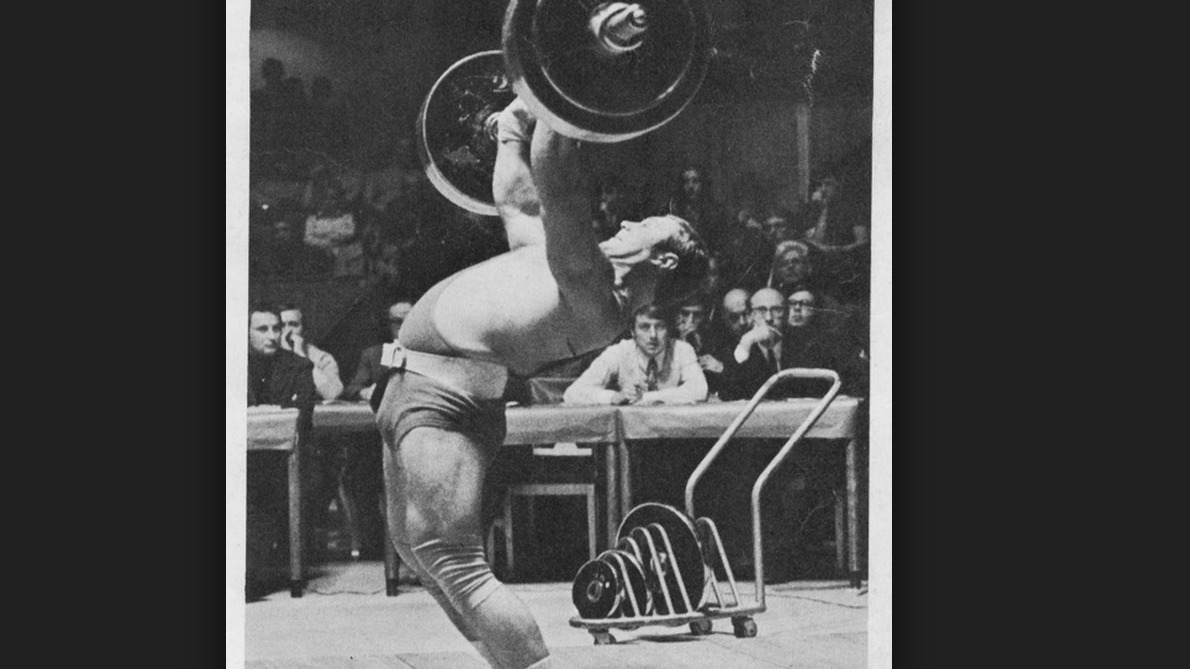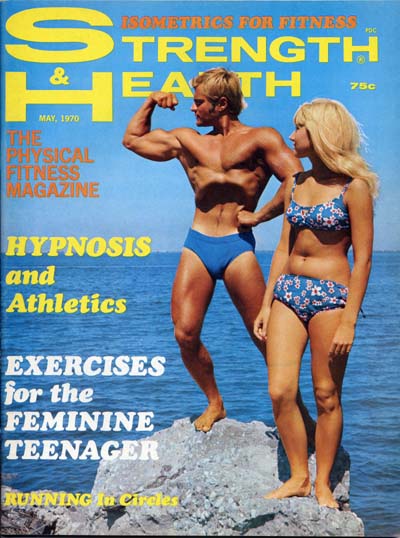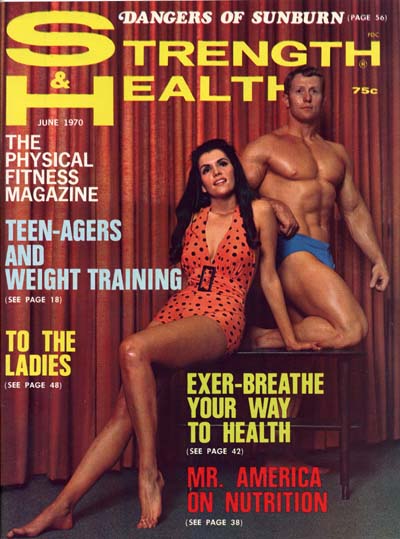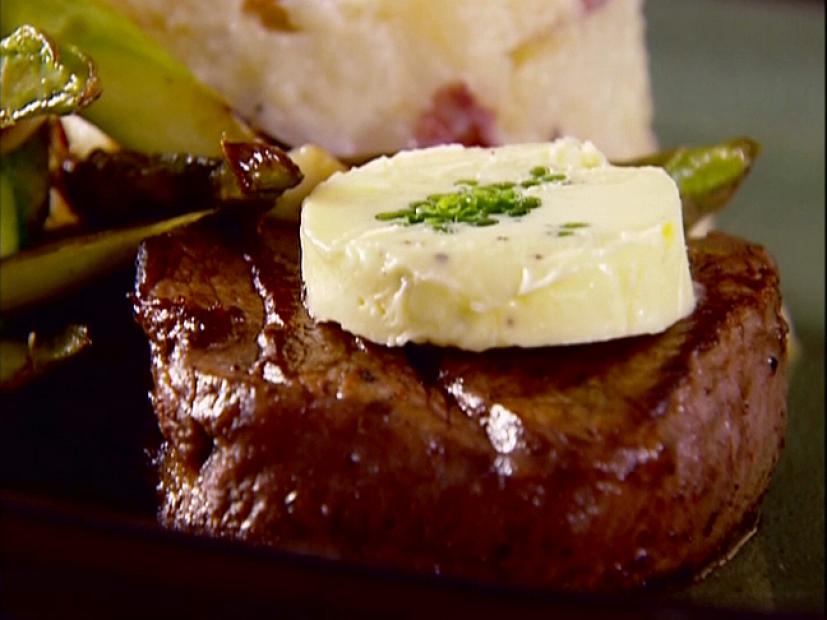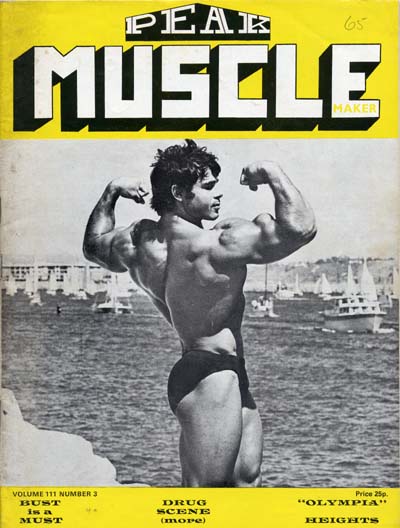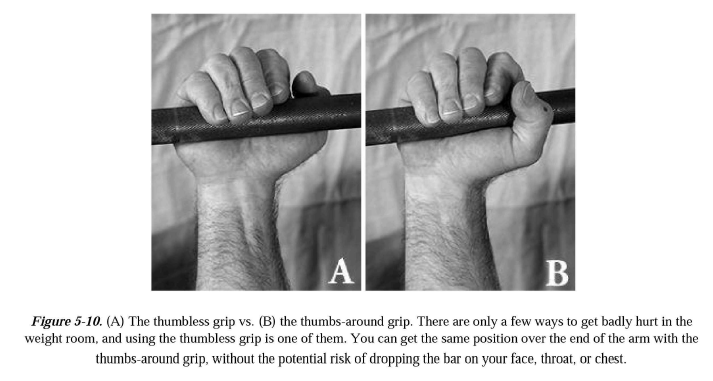The Author in 1915
bent pressing a 115-lb. barbell at age 17.
Mr.and Mrs. Bob Peoples would like to wish you a belated Merry Christmas.
And so would I.
Back in the early 1930s a friend of ours named Mark Berry was editor of Strength magazine. He had training with us in New York at Siegmund Klein's Gymnasium and had observed Henry Steinborn doing his prodigious deep knee bends (squats) with upwards of 500 pounds. Henry would rock the bar on to his shoulders unassisted as he went into the first deep squat, and all of us around the gym had a try at it. We found it strenuous no end. If the descending bar caught you on the neck bone it nearly paralyzed you!
At that time apparently no one had even thought of constructing racks from which to take the bell. Mark drew a picture of such a rack and printed it in Strength, along with some advice about an abbreviated program of exercise designed to make the subject gain weight. Several eager and possibly lazy pupils gave the shortened program a try, and in a few months some wild tales began to come in from the hinterlands from guys like Joseph Curtis Hise, Jacobson, Bullock, Boone and others. Reports of gains of 20 pounds in bodyweight in a month were not uncommon, and I believe it was Jacobson who gained one hundred pounds in a year!
Mark himself gained from 130 to 180 pounds; and thereby hangs a tale. In his early days he had been a diet hound, and has eaten nothing but vegetables and chopped hay for some years until he finally lost all his teeth. When he fixed up the squat rack and began his abbreviated course, he was simply reverting to type. He had always simply worked himself almost to death; he was a "scientific" weightlifter, and would train for hours. When he started squatting he got his new store teeth and started eating too - and what he did to the more substantial foods shouldn't happen to a dog. His advice to all and sundry was to eat five or six times a day and as much as you could hold. The only dietary "don't" he listed was - don't eat anything that bites you first!
His exercise routine was limited to a press on back, two hand curl, squat, and pullover. After going through his former multi-multiple routines, this was simply
for Mark and it was no wonder he started to grow, particularly in the region about six inches below his chest. He further encouraged the growth of the lower chest by adjuring all pupils to refrain from situps. Waist exercise was poison to the lads who were all out for beef at any price.
An early power monster from the era.
At first, Mark did only one set of 20 squats and his exercise period only took up 10 minutes, which was just about all the time he could spare away from the buffet. Other enthusiasts out in the provinces experimented with two, three, and sometimes six or eight sets of squats on an abbreviated program and they grew like weeds in a garden. Mark had promulgated a great discovery - how a skinny guy could get fat.
But he did have something tremendously important - the value of rest and change - and the great importance of leg and back work in creating a bulkier physique.
Previous to this, the squat had been just another exercise. The use of the rack made heavier weights possible that would call for real effort and as use determines structure, the thighs began to bulge and the chest began to deepen. Actually the squat rack was a more important discovery than the squat itself. Anything that takes the pain out of our lives is very much worthwhile. Later discoveries of inclined benches, dorsi pulleys, etc., are anti-pain devices that permit the exerciser to do some good exercises in a less painful manner. We hail these gadgets with delight as a contribution to a more restful and pleasant life. Physical culturists have too long been wearing hair shirts.
To those of you whose faces are wan and drawn, and whose bones seem in danger of punching through the taut skin, I recommend a revised adaptation of the Squat Program, the big discovery of the 1930s. But I offer my version in fear and trembling lest too many of you become big fat sloppy bests with gargantuan appetites and no visible claims to athletic proportions. Just as the drunkard little knows when he downs his first slug of gin and bitters where the trail is going to lead, so many nice clean-cut athletes I used to know have disappeared forever from my ken covered and recovered by rolls and rolls of adipose tissue started in one weak moment a few years ago when they took a bar across their shoulders and made that first fatal dip. O Tempora, O Mores! Mark, why hast thou forsaken me?
A great to-do has been raised about the proper method of breathing in connection with the squat. I find the instructions given by Mr. (Alan) Calvert quite sufficient. Breathe in deeply when you flex the muscles; breathe out vigorously when you relax them. This goes for all exercises, not merely the deep knee bend.
But you will find when you do 20 squats with a heavy weight that long about number 10 you begin to get a bit breathless, so you will naturally pause a bit at the top and start taking 2 or 3 deep pants. This is good. You are expected to puff and pant when you run a hundred yards at top speed. The squats are an athletic feat comparable to the hundred yard dash.
There is some value to beginners in doing light or "dinky" squats with several deep breaths between them. For one thing, the untrained man is so very much weaker than you would suppose him to be that even a set of 20 squats with 20 pounds becomes for him a major athletic feat. The even rhythm makes it easier for lungs and heart to accommodate themselves to their unaccustomed task.
The various ramifications through which the squat program has passed during the past 20 years are indeed enthralling (published in 1950), and the dietary atrocities committed in the sacrificial ceremonies to the Great God Beef would make any European's hair stand on end. We could write a whole book on this subject and enjoy ourselves no end. We remember Mark Berry telling us back about 1934 of a visit he had sustained from one of his squat-and-slop devotees. This 280-pounder arrived just as Mark was finishing breakfast, and naturally Mark invited him to bread and salt, although he didn't happen to have a largely stoked larder at the moment. A makeshift simple meal was provided however with one dozen eggs, a full loaf of bread and a big pot of coffee plus a quart of milk. Besides these edibles, the already over-juiced muscleman drank a two quart pitcher of water.
The squat program in the early days was a case of oversimplification if there ever was one, and unless the subject had some years of regular training to give use to all the muscles he was apt to become a rotund caricature of a strength athlete along the order of the Continental beer drinking iron men at the turn of the century. How much harm has been done organically to these men through gorging and flooding their systems with liquids is horrible to contemplate. Certainly the human body can stand only so much!
The different types of breathing techniques which soon materialized in connection with the squat were forced upon the exercisers by simple cause and effect. The boys who took huge gasps of ozone and did a score or more of squats soon found that they were developing what they termed a "low chest." You may call it what you will. But some of these men have spoiled their physiques for life by getting the same sort of swelling bellies you will see among Indian and Japanese wrestlers. After a while the classic physique boys came along and began squatting and objected strenuously when they saw that suspicious bulge beginning to develop. So they began costal breathing - holding the abdomen in, and making sure the air went into the top of their lungs. They then squatted with the chest held high and the waist held in. This was an improvement.
If you find yourself squatting with a rounded back you are simply asking for trouble. For every action there is an equal and opposite reaction. If you try to make a lower back exercise out of the squat you are certainly going to push that tummy out.
Keep the back flat.
Keep the chest high.
Keep the belly in.
One of the chief virtues of the deep knee bend is that it is just about as strenuous an exercise as you can find. When you do 20 squats with a good heavy bar you will know you have been somewhere. This, I think, is the real reason why many people seem to get noticeable results when they add this movement to their program. Quite probably they have never worked hard enough before to make them really sweat and puff and pant.
Also, you are only as strong as your legs. Most people do not give their legs enough work to do. A heavy squat program places functional demands on the internal organs which they have not previously felt, and consequently this vigorous exercise may serve to cause a sudden change in the basic metabolism of the body. It is shaking the man out of his accustomed groove that makes the squat program work for people who have never really and truly exercised before, although they may have had years of vicarious experience in barbell training. Unless your program makes you breathless at some point or another, you are wasting your time.
Some of the original squat fanatics have mellowed with age. As their waistlines grew they began to complain a little of the severity of going all the way down in the squat. It is no fun to have your stomach bumping against your knees. So they shortened the piston stroke and stepped up the easier part of the program, the breathing. Some of them began to take 10 to 20 breaths between each squat, and soon they were only making only half squats. They continued to grow, as who wouldn't after they had shaken the body metabolism loose and begun to extract more and more flesh from their inordinate food intake.
They also began to do fewer and fewer accessory exercises. Finally they have now arrived at a point where they put the bar on their shoulders (off the rack, of course) and just bounce their shoulders up and down, and snort like a locomotive going up grade. This is the ultimate of something or other, brother. As Arthur Godfrey sings, "I don't want 'em, they're too FAT for me!"
The different types of breathing techniques which soon materialized in connection with the squat were forced upon the exercisers by simple cause and effect. The boys who took huge gasps of ozone and did a score or more of squats soon found that they were developing what they termed a "low chest." You may call it what you will. But some of these men have spoiled their physiques for life by getting the same sort of swelling bellies you will see among Indian and Japanese wrestlers. After a while the classic physique boys came along and began squatting and objected strenuously when they saw that suspicious bulge beginning to develop. So they began costal breathing - holding the abdomen in, and making sure the air went into the top of their lungs. They then squatted with the chest held high and the waist held in. This was an improvement.
If you find yourself squatting with a rounded back you are simply asking for trouble. For every action there is an equal and opposite reaction. If you try to make a lower back exercise out of the squat you are certainly going to push that tummy out.
Keep the back flat.
Keep the chest high.
Keep the belly in.
One of the chief virtues of the deep knee bend is that it is just about as strenuous an exercise as you can find. When you do 20 squats with a good heavy bar you will know you have been somewhere. This, I think, is the real reason why many people seem to get noticeable results when they add this movement to their program. Quite probably they have never worked hard enough before to make them really sweat and puff and pant.
Also, you are only as strong as your legs. Most people do not give their legs enough work to do. A heavy squat program places functional demands on the internal organs which they have not previously felt, and consequently this vigorous exercise may serve to cause a sudden change in the basic metabolism of the body. It is shaking the man out of his accustomed groove that makes the squat program work for people who have never really and truly exercised before, although they may have had years of vicarious experience in barbell training. Unless your program makes you breathless at some point or another, you are wasting your time.
Some of the original squat fanatics have mellowed with age. As their waistlines grew they began to complain a little of the severity of going all the way down in the squat. It is no fun to have your stomach bumping against your knees. So they shortened the piston stroke and stepped up the easier part of the program, the breathing. Some of them began to take 10 to 20 breaths between each squat, and soon they were only making only half squats. They continued to grow, as who wouldn't after they had shaken the body metabolism loose and begun to extract more and more flesh from their inordinate food intake.
They also began to do fewer and fewer accessory exercises. Finally they have now arrived at a point where they put the bar on their shoulders (off the rack, of course) and just bounce their shoulders up and down, and snort like a locomotive going up grade. This is the ultimate of something or other, brother. As Arthur Godfrey sings, "I don't want 'em, they're too FAT for me!"






